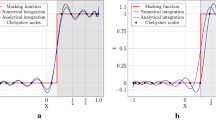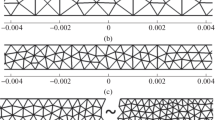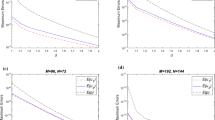Abstract
A Galilean-invariant generalization of the Brinkman volume penalization method (BVPM) for compressible flows, which extends the applicability of the method to problems of the flow around moving obstacles, is proposed. The developed method makes it possible to carry out simulations on non-body fitted meshes of arbitrary structure, including completely unstructured computational grids. The efficiency of the Galilean-invariant generalization of the BVPM for compressible flows around moving obstacles is demonstrated for a number of test problems of the direct reflection of a one-dimensional acoustic pulse from a stationary and moving plane surface, scattering of an acoustic wave by a stationary cylinder, and the subsonic flow of a viscous gas around an oscillating cylinder. The numerical results agree closely with the reference solutions and theoretical estimates of the convergence of the method and they confirm the invariance of the proposed formulation with respect to the Galilean transformations.



Similar content being viewed by others
REFERENCES
U. K. Kaul, “Three-dimensional elliptic grid generation with fully automatic boundary constraints,” J. Comput. Phys. 229 (17), 5966–5979 (2010). https://doi.org/10.1016/j.jcp.2010.04.028
V. A. Garanzha, L. N. Kudryavtseva, and V. O. Tsvetkova, “Hybrid Voronoi mesh generation: Algorithms and unsolved problems,” Comput. Math. Math. Phys. 59 (12), 1945–1964 (2019). https://doi.org/10.1134/S0965542519120078
C. S. Peskin, “The immersed boundary method,” Acta Numer. 11, 479–517 (2002).
R. Mittal and G. Iaccarino, “Immersed boundary methods,” Annu. Rev. Fluid Mech. 37, 239–261 (2005). https://doi.org/10.1146/annurev.fluid.37.061903.175743
R. Steijl and G. Barakos, “Sliding mesh algorithm for CFD analysis of helicopter rotor-fuselage aerodynamics,” Int. J. Numer. Methods Fluids 58 (5), 527–549 (2008). https://doi.org/10.1002/fld.1757
H. Pomin and S. Wagner, “Aeroelastic analysis of helicopter rotor blades on deformable chimera grids,” J. Aircr. 41 (3), 577–584 (2004). https://doi.org/10.2514/1.11484
I. V. Abalakin, V. G. Bobkov, T. K. Kozubskaya, V. A. Vershkov, B. S. Kritsky, and R. M. Mirgazov, “Numerical simulation of flow around rigid rotor in forward flight,” Fluid Dyn. 55 (4), 534–544 (2020). https://doi.org/10.1134/S0015462820040011
I. S. Menshov and M. A. Kornev, “Free-boundary method for the numerical solution of gas-dynamic equations in domains with varying geometry,” Math. Models Comput. Simul. 6 (6), 612–621 (2014). https://doi.org/10.1134/S207004821406009X
E. A. Fadlun, R. Verzicco, P. Orlandi, and J. Mohd-Yusof, “Combined immersed-boundary finite-difference methods for three-dimensional complex flow simulations,” J. Comput. Phys. 161 (1), 35–60 (2000). https://doi.org/10.1006/jcph.2000.6484
E. Arquis and J. P. Caltagirone, “Sur les conditions hydrodynamiques au voisinage d’une interface milieu fluide-milieu poreux: Application à la convection naturelle,” C. R. Acad. Sci., Ser. IIb: Mec. 299 (1), pp. 1–4 (1984).
P. Angot, C. Bruneau, and P. Fabrie, “A penalization method to take into account obstacles in viscous flows,” Numer. Math. 81 (4), 497–520 (1999). https://doi.org/10.1007/s002110050401
G. Carbou and P. Fabrie, “Boundary layer for a penalization method for viscous incompressible flow,” Adv. Differ. Equations 8 (12), 1453–1480 (2003).
N. K. R. Kevlahan and O. V. Vasilyev, “An adaptive wavelet collocation method for fluid-structure interaction at high Reynolds numbers,” SIAM J. Sci. Comput. 26 (6), 1894–1915 (2005). https://doi.org/10.1137/S1064827503428503
Q. Liu and O. V. Vasilyev, “A Brinkman penalization method for compressible flows in complex geometries,” J. Comput. Phys. 227 (2), 946–966 (2007). https://doi.org/10.1016/j.jcp.2007.07.037
Y. Bae and Y. J. Moon, “On the use of Brinkman penalization method for computation of acoustic scattering from complex boundaries,” Comput. Fluids 55, 48–56 (2012). https://doi.org/10.1016/j.compfluid.2011.10.015
R. Komatsu, W. Iwakami, and Y. Hattori, “Direct numerical simulation of aeroacoustic sound by volume penalization method,” Comput. Fluids 130, 24–36 (2016). https://doi.org/10.1016/j.compfluid.2016.02.016
P. Bakhvalov, I. Abalakin, and T. Kozubskaya, “Edge-based reconstruction schemes for unstructured tetrahedral meshes,” Int. J. Numer. Methods Fluids 81 (6), 331–356 (2016). https://doi.org/10.1002/fld.4187
O. Boiron, G. Chiavassa, and R. Donat, “A high-resolution penalization method for large Mach number flows in the presence of obstacles,” Comput. Fluids 38 (3), 703–714 (2009). https://doi.org/10.1016/j.compfluid.2008.07.003
A. Gorobets, “Parallel algorithm of the NOISEtte code for CFD and CAA simulations,” Lobachevskii J. Math. 39 (4), 524–532 (2018). https://doi.org/10.1134/S1995080218040078
A. Gorobets and P. Bakhvalov, “Heterogeneous CPU+GPU parallelization for high-accuracy scale-resolving simulations of compressible turbulent flows on hybrid supercomputers,” Comput. Phys. Commun. 271, 108231 (2022). https://doi.org/10.1016/j.cpc.2021.108231
Second Computational Aeroacoustics (CAA) Workshop on Benchmark Problems, C. K. W. Tam and J. C. Hardin, Eds., NASA Conf. Publ. 3352 (NASA Langley Research Center, Hampton, VA, 1997).
I. Abalakin, N. Zhdanova, and T. Kozubskaya, “Immersed boundary penalty method for compressible flows over moving obstacles,” in Proc. 6th European Conf. on Computational Mechanics: Solids, Structures and Coupled Problems (ECCM 2018) and 7th European Conf. on Computational Fluid Dynamics (ECFD 2018), 11–15 June 2018, Glasgow, UK, pp. 3449–3458.
ACKNOWLEDGMENTS
The results were obtained using the equipment of the Center for Shared Use, Keldysh Institute of Applied Mathematics, Russian Academy of Sciences (http://ckp.kiam.ru).
Funding
This work was supported by the Russian Science Foundation, project 20-41-09018.
Author information
Authors and Affiliations
Corresponding authors
Ethics declarations
The authors declare that they have no conflicts of interest.
Rights and permissions
About this article
Cite this article
Zhdanova, N.S., Abalakin, I.V. & Vasilyev, O.V. Generalized Brinkman Volume Penalization Method for Compressible Flows Around Moving Obstacles. Math Models Comput Simul 14, 716–726 (2022). https://doi.org/10.1134/S2070048222050180
Received:
Revised:
Accepted:
Published:
Issue Date:
DOI: https://doi.org/10.1134/S2070048222050180




